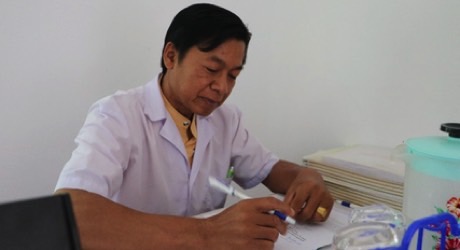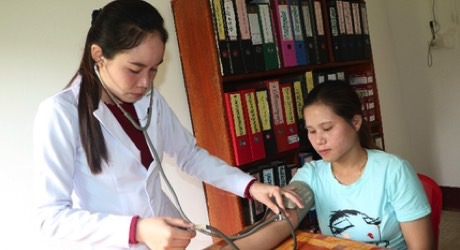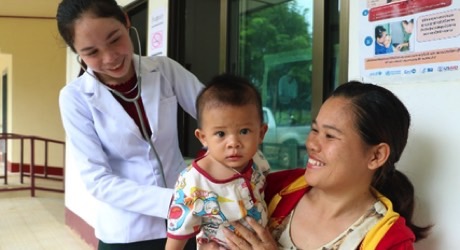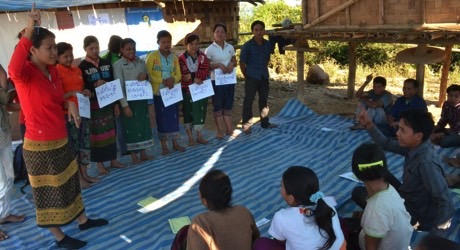Project Background
This project is in direct response to the recognised negative long-term development implications of under-nutrition for individuals, households and communities, and the fact that Laos records the highest rates of under-nutrition in South East Asia.
It targets the provinces recording rates of under nutrition that are significantly higher than the national average of 44% (including 61% of boys and 53% of girls under 5 are stunted within one of the project areas of Saravan province). The integration of Maternal Newborn and Child Health & Nutrition (MNCH-N) and hygiene interventions aligns with global evidence that such combined investments are essential and more successful in achieving optimal nutritional outcomes than investment in one of these approaches alone.
Project Outcomes
Key successes:
- Improved Hygiene practices. 3,169 people (844 men, 1,009 women, 577 boys and 739 girls) habitually hand washing with soap at critical times (e.g. after defecating).
- Monitoring Tool implemented in 9 communities across Saravan and Oudomxay provinces to monitor outcomes and efficacy of activities
- 33 (19 women; 14 men) health centre staff, including midwives, were trained in 'puern tae' (‘True Fiend’) methodology, gaining trust and building relationships which allows for better processes for providing clean, safe, respectful care around the time of birth, and Early Essential Newborn Care (EENC).
- Nutrition activities goals on track (including cooking demonstrations, growth monitoring) in 24 communities in Saravan and Oudomxay (480 people - estimated 72 men, 168 women, 120 boys and 120 girls).

This project has also been successfully educating the community on the integral role of parents, especially mothers, in promoting improved nutrition of pregnant and lactating women, and the developing and newborn child through breastfeeding, particularly in the first six months of life.
In order to draw more patients to come to health centres, Plan and health partners are also successfully applying a Puern Tae (‘True Friend’) approach in seven health centres in Saravan Province. This approach helps health workers to understand how important it is to develop good relationships with community members, provide supportive and appropriate advice, and maintain a clean and welcoming space in the health centre that community members feel comfortable and confident to access.
Activities like these are incredibly important for the long term sustainability of these services and community uptake.
Project Challenges
Health centres may not always have enough space allocated as a dedicated delivery room/area which may limit the project's ability to enable health centre staff to provide improved, delivery and post-natal care services.
We are working with health centres to either modify or change room locations within the health centre where possible to provide adequate delivery room facilities.
Additionally it can be challenging to engage men. Few men participate in care giving roles as identified through the Village Health Development Plan (VHDP) process and project activities limiting the benefit to women and children.
The project's Puern Tae (‘True Friend’) approaches are designed to get more men involved and promote greater/more equitable sharing of the responsibilities for child care giving.

Partners and Community
Attitudes within the community:
We’ve seen great uptake of services and support offered through the health centres.
“It is a good sign when villagers start coming to the health centre for treatment, in particular giving birth at the health centre. This shows us that villagers understand and are concerned about their health. In other hand I think that they trust us” – Mr Somphone Sivixay, the Deputy Head of Saenwang Health Centre.
With support from Plan International Laos, health centre staff regularly arrange mobile clinic activities which allows health staff to meet children, mothers, as well as pregnant women, in their villages to promote hygiene and sanitation, provide vaccinations and antenatal care for pregnancies. This activity happens regularly in the third week of each month.
This has been very well received and communities have shown a very positive attitude to this outreach work. It really motivates people to use these services more and fosters trust by helping them build relationships with the health care workers.
Partnerships:
Partnerships are the glue that binds our work within the community, and we’re really proud of how our partnerships are working.
Trained sub-national Health Teams have been engaging children, adults of reproductive age and elderly women and men through a community-led Village Health Development Plan (VHDP) process to identify, prioritise, plan and promote optimal growth and development actions for children in their first 1,000 days. The community has been very engaged with these activities.
Health workers also provide technical and material support for communities, and especially women of reproductive age (15-49 years), to implement their VHDPs and to develop positive individual and household health-seeking practices, hygiene, feeding, early stimulation practices and nutrition ahead of and during pregnancy, as well as immediately after delivery and in the early years of children’s lives.
Without strong partnerships to deliver important services, especially at the grassroots level, projects such as this could not exist effectively.
Of course, we also work closely with governments ensuring long term take up and sustainable pathways to continue to deliver against their countries goals.

Case Study: Sengvangyai Health Centre
Sengvangyai Health Centre is located 37km from the Saravan provincial capital and services 11 villages (around 5,500 people). It is difficult to cover such a large area and to ensure quality services, good hygienic conditions and to reach those that do not live close to the Health Centre.
In 2018, the project supported Sengvangyai Health Centre in a number of ways. Firstly, to improve its Maternal and Child Health services for pre-natal, delivery and post-natal care so that mothers can give birth in hygienic and safe conditions and are able to recover before travelling home. The team handles more than 300 cases per month and has seen an increasing number of pregnant women using the Health Centre for antenatal care and delivery – roughly 5-7 cases per month.
“It is a good sign when villagers start coming to the health centre for treatment, in particular for giving birth. This shows us that villagers understand and are concerned about their health. On other hand I think that they trust us.”– Mr Somphone Sivixay, the Deputy Head of the Health Centre.
With support from the project, the Health Centre staff also regularly undertake mobile clinic activities in villages to promote hygiene and sanitation, provide vaccinations and antenatal care. This activity happens every month, which also in turn encourages villagers to use the Health Centre’s services.
“I delivered my second child at Sengvangyai Health Centre: it’s hygienic and I am familiar to all the health staff. They are very kind. I feel safer to deliver at this Health Centre. There’s no doubt that I come here for antenatal care during my third pregnancy – and of course I’ll deliver here.” – Ms. Khamphou, a 26 year old pregnant woman and mother of two children who comes to the Health Centre for antenatal care.

Ms. Khamnoi (pictured above) brought her 7 month old son for a check up with Ms Douangchai.
“I am sure that I’ll come to have antenatal care and deliver at this health centre for sure. It is much more convenient and has enough space and facilities for mother and new-born babies. It is so exciting!” – Ms. Khamnoi, a 34 year old mother to two children who delivered her second baby at the health centre. Today she takes her seven month old baby for a regular check-up with the health staff.
What Next?
Having focused on capacity building with health care workers, ongoing participatory and inclusive Village Health Development Planning processes will ensure that interventions meet actual needs, are delivered in a way that is acceptable and effective for target beneficiaries, and builds an ongoing collective capacity to self-identify and address a community’s own needs.
This Project also aligns with the Government of Lao PDR’s Multi-Sectoral National Food and Nutrition Security Action Plan 2016-2020 (NFSAP) so will be supported through its facilitation of community-driven action planning for improved health and nutrition.
When a project has strong partnerships and local capacity building activities in its foundation, such as this project, the long term benefits become deeply entrenched and sustainable.
Can I Visit the Project?
Visits may be available, on request. Please contact Plan International Australia directly.
Project Details
This project is in direct response to the recognised negative long-term development implications of under-nutrition for individuals, households and communities, and the fact that Laos records the highest rates of under-nutrition in South East Asia.
Our project targets the provinces recording rates of under nutrition that are significantly higher than the national average of 44% (including 61% of boys and 53% of girls under 5 are stunted within one of the project areas of Saravan province). The integration of Maternal Newborn and Child Health & Nutrition (MNCH-N) and hygiene interventions aligns with global evidence that such combined investments are essential and more successful in achieving optimal nutritional outcomes than investment in one of these approaches alone.
Our project design and intended outcomes have been informed by a detailed situation analysis of the causes and determinants of poor nutrition in rural Laos, and through consultations with communities, civil society organisations (known as NPAs) and government stakeholders at the sub- national level. As well as always including our beneficiaries insights and knowledge to inform our work.
Project Overview
Over the lifetime of this project Plan will work with and through government, non-government and community stakeholders to deliver an integrated Maternal Newborn and Child Health & Nutrition (MNCH-N) project in two provinces to achieve a number of impacts.
Project goals include:
- Reduction of stunting in girls and boys aged 0-23 months.
- Improved nutrition among women in 48 communities in Oudomxay and Saravan provinces by 2019. This is based on an increased percentage of pregnant and breast feeding women consuming food from at least 4 food groups
- Improved nutrition and hygiene conditions in 89 villages across Saravan and Oudomxay provinces; In Oudomxay this equates to 13,000 people. In Saravan this equates to 21,210 people

This project will also educate the community on the integral role of parents, especially mothers, in promoting improved nutrition of pregnant and lactating women, and the developing and newborn child through breastfeeding, particularly in the first six months of life.
We also seek to identify and address a number of the social determinants, attitudes and practices impacting on women’s and children’s health, well-being and nutrition, such as household decision- making for procurement of nutritious food, workloads of women during pregnancy and opportunities to access antenatal care services.
Projects such as this represent great sustainability as it invests in building the skills and knowledge of government and local civil society, allowing for future replication of project activities.
What's Covered in Project Costs
Key activities include:
- Training 33 (19 women; 14 men) health centre staff, including midwives, in 'puern tae' methodology - providing clean, safe, respectful care around the time of birth, and Early Essential Newborn Care (EENC).
- Mapping existing stakeholder commitments in nutrition-sensitive and nutrition-specific interventions against the 22 priority actions in the National Nutrition Strategy (NNS).
- Implementing monitoring tools in 9 communities across Saravan and Oudomxay provinces to track outcomes and improve service delivery.
- Resources required to deliver Nutrition activities (including cooking demonstrations, growth monitoring, health and nutrition education) undertaken in 24 communities in Saravan and Oudomxay (approximately 480 people - estimated 72 men, 168 women, 120 boys and 120 girls).

Partners and Community
It takes a tribe of partners and community support to deliver effective outcomes to our beneficiaries. Some of these include:
Government partners form multi-disciplinary (including health workers) Health Teams, while in Oudomxay Province the local NPA (civil society organisations) Promotion of Family Health Association are an additional project partner. Plan Laos provides training and mentoring to Health Teams at sub-national level and with the local NPA partner which enhance the skills of midwives and health workers to deliver improved, safer and respectful antenatal, delivery and post-natal care services.
Trained sub-national Health Teams and the NPA will engage and facilitate children, adults of reproductive age and elderly women and men through a community-led Village Health Development Plan (VHDP) process to identify, prioritise, plan and promote optimal growth and development actions for children in their first 1,000 days.
Plan, government stakeholders and health workers will provide technical and material support for communities, and especially women of reproductive age (15-49 years), to implement their VHDPs and to develop positive individual and household health-seeking practices, hygiene, feeding, early stimulation practices and nutrition ahead of and during pregnancy, as well as immediately after delivery and in the early years of children’s lives.
Part of a Larger Strategy
The Project aligns with the Government of Laos Multi-Sectoral National Food and Nutrition Security Action Plan 2016-2020 (NFSAP) through its multi-sectoral and collaborative approach with stakeholders at the provincial and district levels, and through its facilitation of community-driven action planning for improved health and nutrition. The Project will support delivery of 8 out of 14 of the NFSAP’s priority interventions for Health, including: promotion of, and counselling for, breastfeeding and infant young child feeding; food supplementation for pregnant and lactating women and children under 2 years; improved clinical management of acute malnutrition; growth monitoring for children under 5; and strengthened nutrition surveillance and reporting.
This project also aligns with DFAT’s priorities for Laos, particularly rural development and improving basic services for poor communities.
Plan Australia's Sustainability Outcomes
For Plan International Australia sustainability of our projects and the long term impact to the communities we serve is incredibly important to us, it also underpins our program design.
Sustainability outcomes for this project will be achieved through capacity development and appropriate interventions at various levels:
- At community level: Participatory and inclusive Village Health Development Planning processes will ensure that interventions meet actual needs and are delivered in a way that is acceptable and effective for target beneficiaries, and builds an ongoing collective capacity to self-identify and address a community’s own needs.
- At district and provincial levels: Understanding amongst government leaders of the value and potential of community-led action for health and development will be increased, encouraging them to support such community-led action in future. As well as developing the skills of local NPA that have long term commitments to remain operational within the project area (particularly in Oudomxay province).